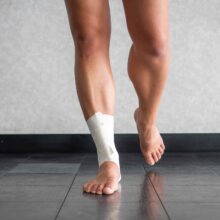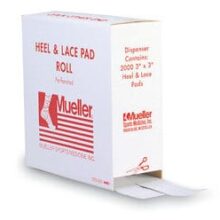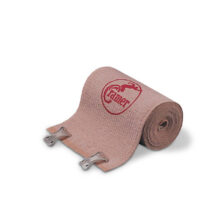Taping, Wrapping & Padding
In sports medicine, athletic taping, wrapping, and padding are essential techniques that serve distinct roles in injury prevention, support, and rehabilitation.
Each method has its unique application and purpose, contributing to the overall care and well-being of athletes. Let’s explore the roles played by taping, wrapping, and padding in sports medicine:
Athletic Taping
Athletic taping involves the application of adhesive tape to specific body parts to provide support, stability, and injury prevention.
The primary goals of taping are to restrict excessive movement, reinforce weakened or injured areas, and enhance proprioception (the body’s awareness of its position in space).
Athletic taping techniques vary depending on the injury or area being addressed. Common taping methods include ankle taping, wrist taping, and knee taping. The benefits of taping include:
– Joint Stability: Taping supports ligaments and stabilizes joints, reducing the risk of sprains, strains, or ligamentous injuries. It restricts excessive movement while allowing for a functional range of motion.
– Injury Prevention: Taping can be used proactively to prevent injuries, particularly in sports with high-risk movements or contact. It provides an extra layer of support and reinforcement to vulnerable areas.
– Rehabilitation Aid: Taping aids in the rehabilitation process by providing support to injured structures, facilitating healing, and allowing athletes to engage in controlled movement or physical activity during the recovery phase.
Wrapping
Wrapping involves the use of elastic bandages or compression wraps to provide support, compression, and protection to injured or vulnerable areas.
Wrapping is commonly employed in joint injuries or areas that require extra stability or compression. The key roles of wrapping in sports medicine include:
– Compression and Edema Control: Wrapping with elastic bandages or compression wraps helps reduce swelling and edema by providing gentle compression, promoting lymphatic flow, and supporting the absorption of fluid from the injured area.
– Joint Support: Wrapping supports and stabilizes joints, helping to prevent excessive movement, hyperextension, or subluxation. It can be particularly beneficial in sports with repetitive or high-impact movements that put stress on the joints.
– Pain Relief: Compression wraps can help alleviate pain and discomfort by providing a sense of pressure and support to the injured area. The gentle compression may also stimulate mechanoreceptors, reducing pain signals.
– Muscle Support: Wrapping can provide support to fatigued or weak muscles, reducing muscle vibration and minimizing the risk of muscle strains or fatigue-related injuries.
Padding
Padding involves the application of cushioning materials or protective pads to reduce impact forces, absorb shock, and provide additional protection to vulnerable areas.
Padding is typically used in areas prone to repetitive trauma, direct impact, or friction. The roles of padding in sports medicine include:
– Impact Absorption: Padding absorbs and disperses impact forces, protecting bones, joints, and soft tissues from direct trauma. It can be particularly valuable in sports that involve collisions, falls, or contact with hard surfaces.
– Pressure Distribution: Padding helps distribute pressure evenly, reducing the risk of pressure sores, blisters, or skin irritations. It can be applied to areas where equipment, such as helmets or shoes, may cause friction or discomfort.
– Joint Protection: Padding can provide an additional layer of protection to vulnerable joints, such as the knees or elbows, reducing the risk of contusions, bursitis, or other impact-related injuries.
– Rehabilitation Support: Padding may be used during rehabilitation to protect healing tissues or injured areas, allowing athletes to engage in controlled movement or activities without exacerbating the injury.
– Comfort and Confidence: Padding can enhance comfort, allowing athletes to focus on their performance without distraction or discomfort. It can also provide psychological confidence, especially for athletes returning from injuries, as it offers a sense of protection and security.






